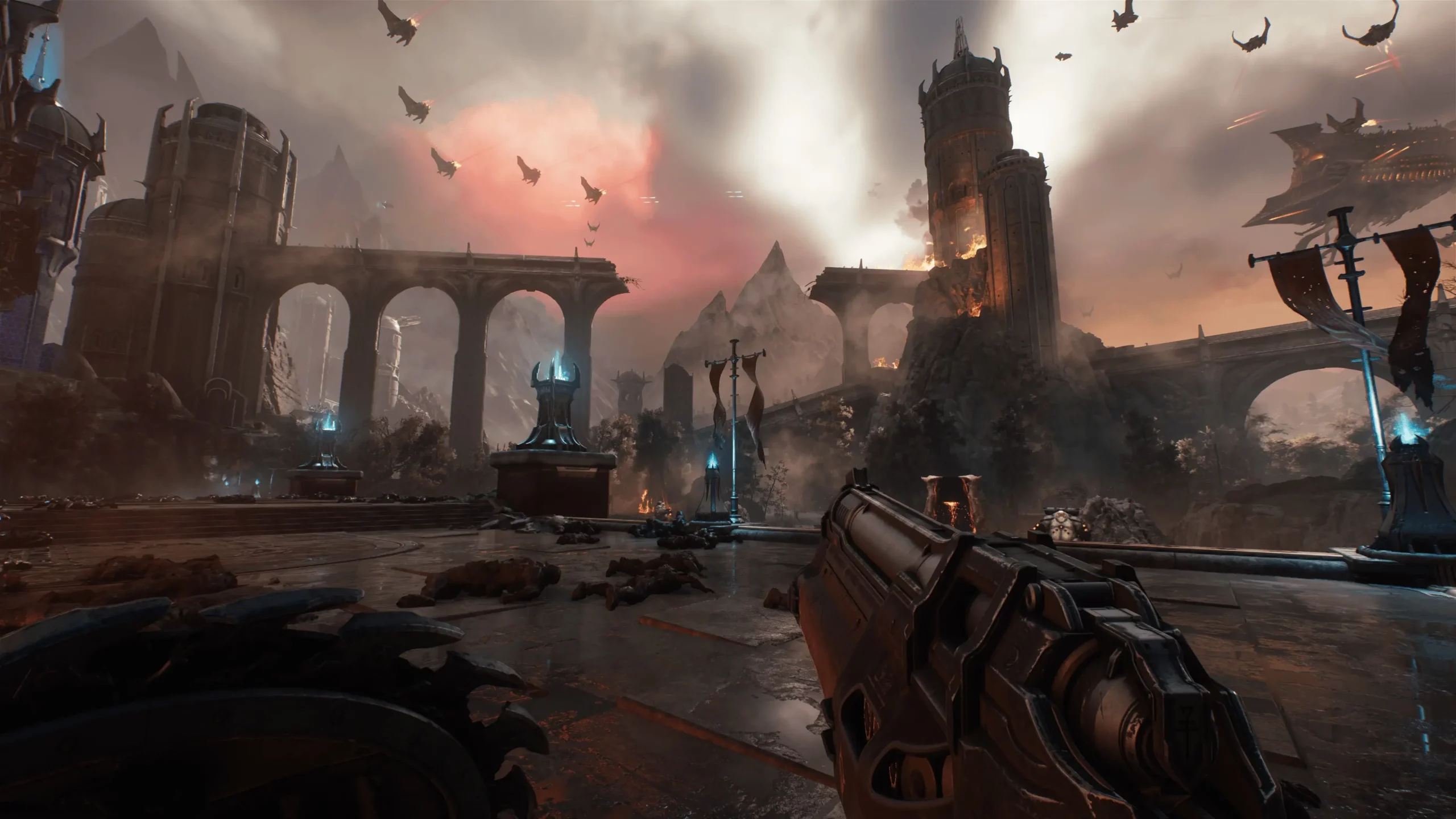If there’s one thing that has maintained Doom’s prestigious position at the top of first-person shooter rankings, it’s the franchise’s bold reinvention of what it means to be a formidable, superpowered one-person army against Hell’s legions. The past three decades have seen various iterations: classic run-and-gun gameplay, jumpscare-focused horror, modern reimaginings of traditional gameplay, and the mobility-centered action of Doom Eternal (2020). Doom: The Dark Ages takes a significantly different approach from Eternal, which many regard as one of the finest shooters ever created. The differences are so pronounced that initial impressions might be unfavorable – heavier movement mechanics, absence of double jumps or air dashes, and overwhelming chaos with expansive battlefields swarming with enemies from all directions.
However, after several hours into the 20+ hour campaign, as the arsenal expands and enemy dispatching methods diversify, players begin to understand and appreciate what The Dark Ages offers. By the conclusion, players will likely find themselves with a satisfied grin as they rip and tear through demonic hordes.
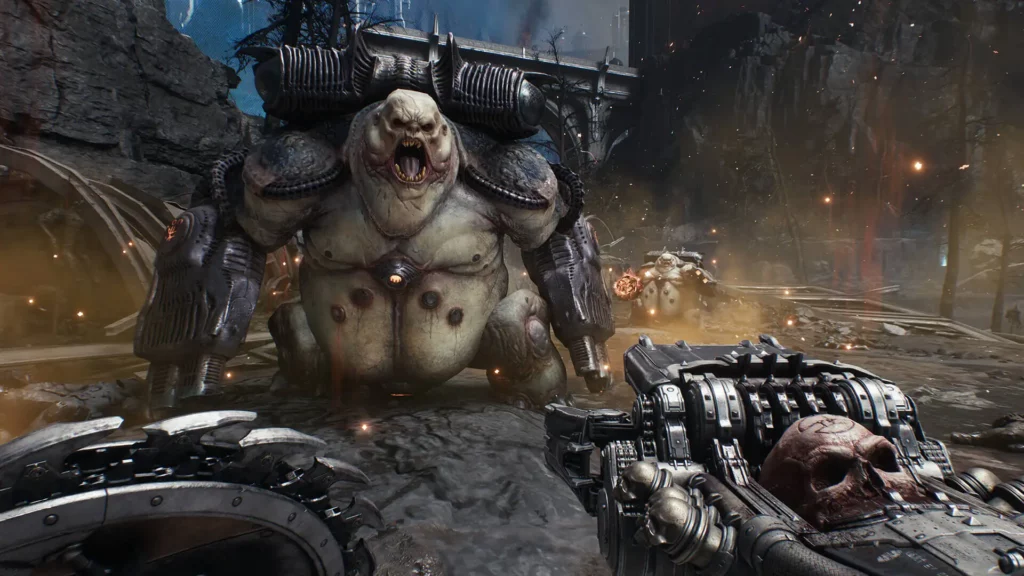
A Deeper Dive into Doom Lore
The Dark Ages campaign focuses on establishing dark sci-fi fantasy elements. It follows the Doom Slayer before his awakening in a UAC space station sarcophagus in Doom 2016. While the Slayer remains primarily a vehicle for aggressive gameplay rather than character development, the story succeeds in filling narrative gaps in the Doom universe, exploring the history of human-demon conflict, and further developing both the human Sentinel defenders and the deity-like Maykrs. The storytelling effectively transports players through varied hellish landscapes, including sci-fi medieval castles and a particularly welcome journey to the Lovecraftian-inspired Cosmic Realm, featuring mind-bending puzzles and eerie settings that differ from previous installments.
Perhaps the narrative’s greatest strength is that it no longer portrays the Slayer fighting alone against unnamed hellish forces. Human companions play central roles in the plot, creating a genuine sense of fighting alongside humanity in an all-out war against demons. There’s legitimate intrigue surrounding the mysterious Maykrs and their involvement in the conflict. This represents the strongest storytelling the Doom series has ever achieved, even if that’s not particularly difficult to accomplish.
Captain Slayer’s Shield
Beyond the setting, what primarily distinguishes The Dark Ages from previous entries is the addition of the Slayer’s Shield and its accompanying abilities. Rather than avoiding damage through constant movement and frantic jumping, players are encouraged to charge directly into danger with shield ready to block or deflect enemy attacks. Red attacks can be blocked until the shield depletes, while green attacks can be reflected with well-timed guards to inflict substantial damage and stun most affected monsters. Even on Nightmare difficulty, the parry timing remains generous, though players can adjust this and other difficulty modifiers in the menu settings.
Another key shield technique is a charging bash attack that quickly closes the distance between the player and enemies. This functions similarly to the Super Shotgun’s grapple from Doom Eternal, but operates faster, works with any weapon, and recharges relatively quickly. The ability to use the shield both defensively to block and stun, and offensively to rapidly engage or disengage, elevates The Dark Ages’ combat by maintaining fast-paced excitement despite removing double jumps, quick dashes, and rapid weapon swapping. The game delivers the best of both worlds – the Slayer remains extremely mobile while feeling like a heavily armored tank, complete with thunderous footsteps and landing shockwaves.
The shield offers additional utility beyond these functions. Eventually, players gain the ability to throw the shield Captain America-style, instantly decapitating numerous weaker enemies simultaneously. When used against larger foes, it continuously buzzsaws into them, temporarily incapacitating them. This proves particularly effective against Arachnotrons that bombard players with unblockable bullets. By tossing the shield to interrupt their attack, dashing in, and delivering a single super shotgun blast, they become ready for execution.
Strategic Combat Evolution
These abilities are crucial for surviving difficult encounters because almost every enemy in The Dark Ages has exploitable weaknesses – unlike Doom Eternal, these are rarely weapon-specific. There’s no longer a need to constantly switch between weapons for specific tactics, such as using the combat shotgun to lob grenades into Cacodemon mouths, switching to rifles to snipe Revenant weapons, or alternating super shotgun and ballista shots to damage Marauders. While such tactics have their merits, The Dark Ages manages to deliver exhilarating gameplay without requiring professional-level actions per minute on higher difficulties.
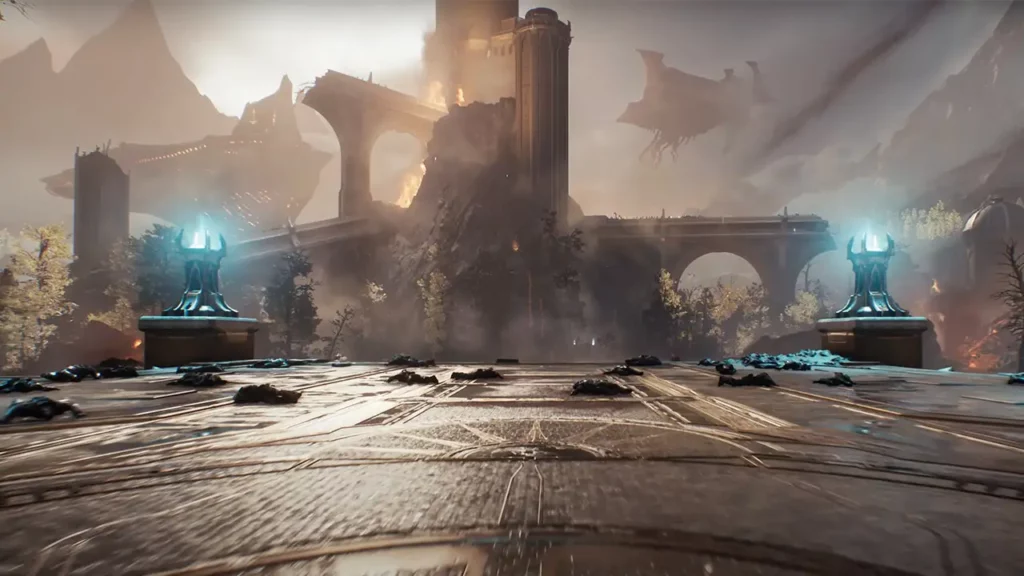
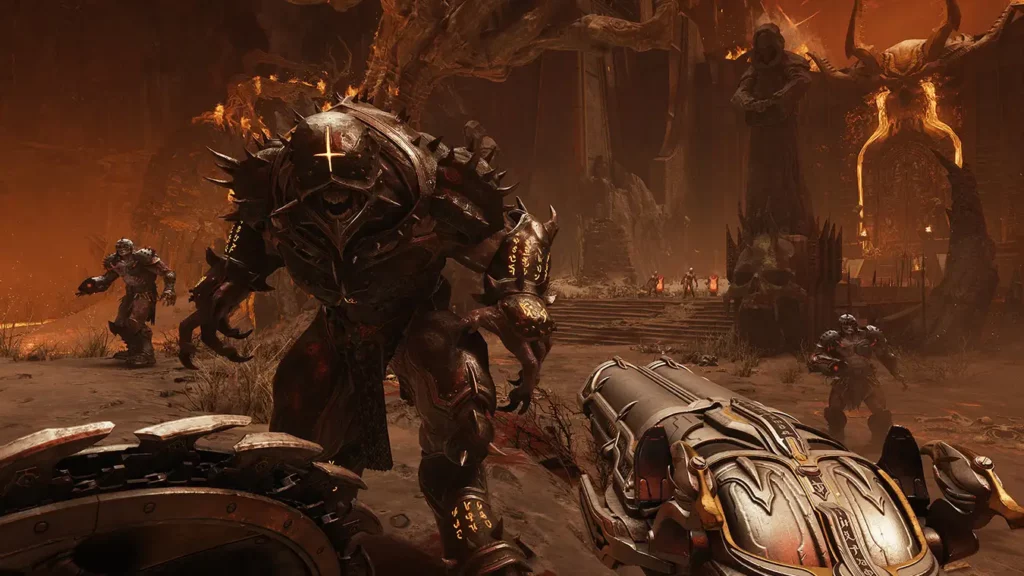
The enemy roster largely features familiar adversaries from previous Doom titles – Imps, Hell Knights, Mancubi, Arachnotrons, and even the Cyberdemon, all behaving as expected. Others have received redesigns to match the new setting, such as the Pinkie transformed into a mount with a demon archer rider, and a new Cacodemon variant from the Cosmic Realm. The Dark Ages even resurrects the Vagary mini-boss, unseen since Doom 3. The enemy variety remains impressive, with even familiar foes featuring new tricks to better integrate with The Dark Ages’ combat system.
Notably, the developers have dramatically increased the number of on-screen enemies compared to previous titles. Bird’s-eye views of battlefields truly resemble all-out warfare against Hell’s minions. This initially caused frustration due to enemies spawning behind without warning, but required merely an adjustment in combat approach – using shield bash to disengage as well as engage to maintain battlefield control.
One significant change is the removal of the iconic Chainsaw, previously used since Doom 2016 to instantly kill enemies and replenish ammo. It’s been replaced with a new melee system enabling close-quarters combat that also restores ammunition. Though the satisfaction of sawing through smaller enemies is missed, this system better aligns with The Dark Ages’ emphasis on rushing toward combat rather than away from it. Additionally, melee attack “ammo” pickups appear more frequently than Chainsaw fuel in previous titles, reducing ammunition shortages – a welcome improvement.
Weapons of Destruction
Regarding weaponry, The Dark Ages presents traditional weapons with visual modifications for period-appropriate aesthetics, but their functions remain largely familiar. All the satisfyingly powerful standards are present: combat and super shotguns, an assault rifle firing railspikes instead of bullets, a plasma rifle, and a single-shot sniper-like steel ball launcher, among others. The only truly unique weapon is the Skullcrusher Pulverizer, functioning similarly to a chaingun but with tremendous spread capable of decimating vast numbers of weaker enemies. While enjoyable for handling The Dark Ages’ increased enemy counts, the shield throw often proves more effective for crowd control, particularly with upgrades that enhance shield charge upon use.
An interesting weapons system innovation is that each gun has a complementary weapon sharing the same ammunition type, allowing quick swapping between them. For example, the rocket launcher pairs with a grenade launcher, while the wide-area Pulverizer complements the concentrated-fire Ravager. This provides extensive gunplay variety, and although weapon switching isn’t forced as in Doom Eternal, players will likely cycle through their arsenal simply because it’s entertaining.
The most impressive aspect of The Dark Ages’ toolkit – a credit to the developers’ weapon design philosophy throughout the series – is that every weapon remains useful throughout the entire campaign. Players will develop preferences, perhaps favoring the Super Shotgun, Rocket Launcher, and Steelshot, but even early weapons remain viable with upgrades. Low on armor? Switch to the upgraded combat shotgun that ignites enemies and drops armor shards. Need health? The Ravager makes enemies bleed health pickups. Need to incapacitate a target while damaging nearby enemies? Throw the shield into the primary target, shoot it, and watch bullets ricochet to surrounding foes.
Making combat even more engaging, these abilities and weapons are introduced at a measured pace throughout the campaign. Gameplay never stagnates as each level provides a new gun, shield ability, melee weapon, or enough currency for shop upgrades that meaningfully alter existing equipment.
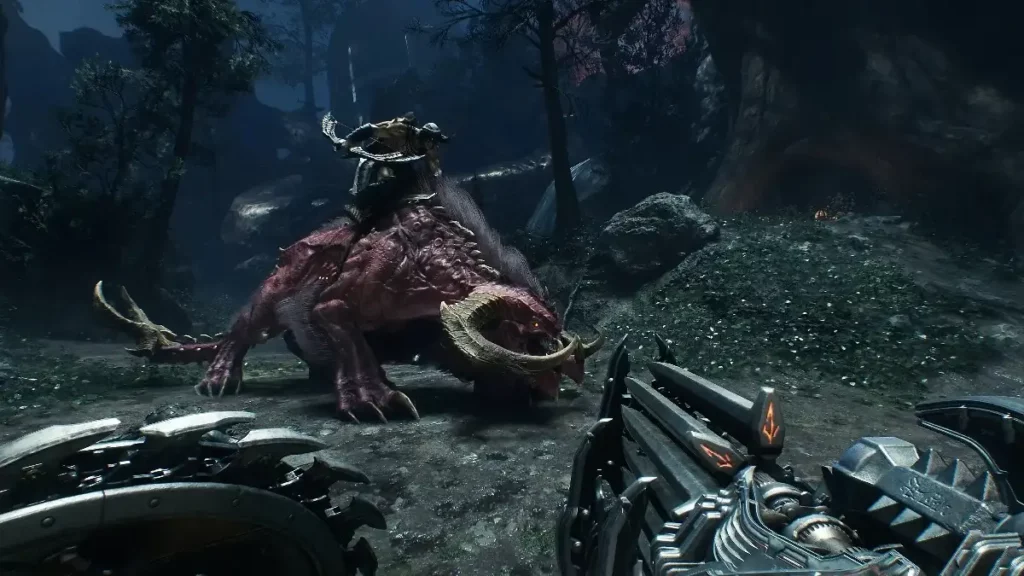
Expansive Environments and Epic Moments
The desire for upgrades encourages exploration to find both currency and traditional Doom collectibles like figurines, weapon skins, and lore items. The Dark Ages’ levels accommodate exploration wonderfully. Though varying in size, even smaller stages exceed the series’ standards, while larger levels are truly massive. These enormous, open battlefields contain numerous secrets, challenging enemy encounters, and breathtaking vistas.
Between frantic combat sequences, the game features giant mecha battles and flying sections where players pilot the Slayer’s dragon. Yes, the Doom Slayer now has a dragon. These sections lack the depth of the main gameplay, with mecha segments consisting primarily of simple dodge-punch patterns and dragon sections following similar dodge-shoot sequences. However, they function effectively as turret sequences – infrequent and brief enough to avoid disrupting pacing while delivering impressive moments in accompanying cutscenes.
The soundtrack deserves special mention – it’s absolutely phenomenal. Fans of previous Doom games will have certain expectations, but the heavy metal soundtrack exceeds them, compelling players to revisit levels after completing the campaign just to experience the music without it being overshadowed by shotgun blasts, explosions, and dying demons.
The Verdict
Far more than merely “More Doom,” Doom: The Dark Ages presents a fresh interpretation of the legendary shooter series – heavier and more grounded, yet equally energetic and exhilarating. The shield represents an outstanding addition offering numerous offensive and defensive options which, combined with the extensive traditional Doom arsenal, provides countless exciting methods for dispatching the thousands of demons standing in your path. Add an enhanced heavy metal soundtrack supporting excellent weapon, level, and enemy design, and the developers have once again demonstrated that, like a point-blank super shotgun blast, they don’t miss.
